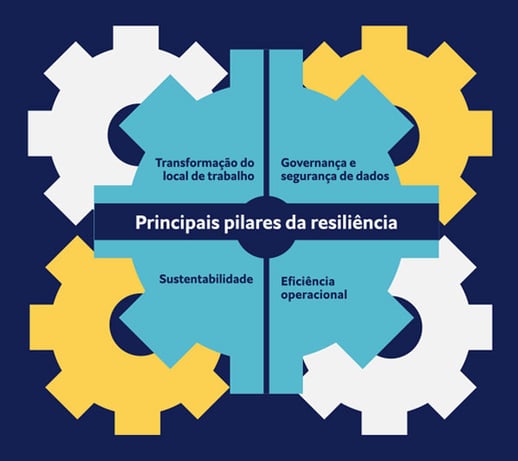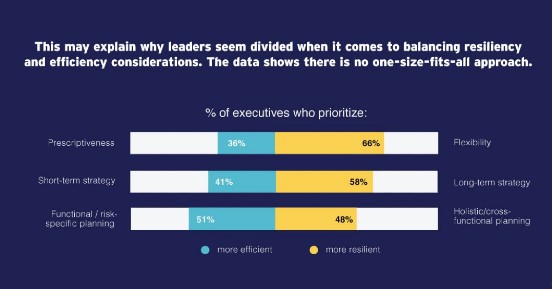
Business Challenges
Amplify risk management. Strengthen resilience. Empower your organization.
Risk is on everyone’s mind, but what can you do to make risk management a reality for your organization? Explore these resources to find out how to build risk awareness and strengthen resilience.
The research on risk
While 90% of global executives believe risk identification is more important than ever, 57% say their organization needs to improve cross-functional collaboration to better identify and manage risks.
Here’s what it takes to evolve risk management from a siloed function in your organization to an integrated and active part of your culture.

Risk reset: anticipating what lies ahead
Explore risk management trends
Leaders worldwide are rethinking how to approach risk management, relying on diverse internal functions and a variety of risk factors to raise risk awareness throughout their organizations.
Explore these infographics for a deeper look at emerging risk management trends.
What do our experts say about risk management?

Sustainability reporting can be a useful tool for identifying KPIs that might not be part of traditional performance measurements and could represent an opportunity for cost savings or operational improvements. Data-driven insights can help prioritize action to minimize risk and accelerate opportunities for organizations.

Compliant and consistent management of a company’s IT assets as they reach the end of their lifecycle is a critical aspect of risk mitigation that is frequently underestimated. It requires proactive efforts to plan, measure, and audit the effectiveness of a program in order to ensure security of the company’s data and data bearing assets.

Risk is a factor in any business endeavor. Our job is to plan for and properly manage the activities that we know can create increased risk. It is also incumbent upon us to share what we've learned from the past to anticipate potential risk. Best practices, experienced personnel, appropriate resources, as well as proper communication and collaboration, are essential to risk mitigation, especially during a real estate change.

Risk aware organizations have begun to review their legacy paper inventories by using tools and subject matter experts to enable compliant and defensible decision-making about their records.
Risk and resilience go hand in hand
Why everyone in your organization should be a risk manager to strengthen resilience
We’ve all become more resilient in recent years—as individuals, as employees, as employers and, of course, as organizations. But while risk and resilience continue to be popular for large-scale organizational discussion, what does it actually mean to be risk aware and resilient at this level?
In 2022, we sponsored a global study by Economist Impact of 600+ executives across five continents to explore the topic of resilience, which led to our 2023 research on risk. These insights were obtained through survey analysis, desk research, and expert interviews to identify changing interpretations of organizational resilience. Here’s what we uncovered.

Is your organization as resilient as you think?
So what is organizational resilience?
No real progress on organizational resilience can be made until we recognize that it requires cross-functional collaboration.
This is the only way to get buy-in up and down the enterprise and across global teams and time zones. However, before that happens, all stakeholders need to agree on what the complex—and often misunderstood—topic of business resilience is.
To be a resilient organization is to be nimble, flexible, and able to withstand both expected and unexpected shocks.

Disruption is going to be an enduring part of our business world, so therefore, resilience will need to be an enduring part of our business approach.
The four pillars of modern resilience

Pillar 1: Workplace transformation
While almost 80% of executives realize that having an agile workforce is a much bigger priority since the pandemic, they have plenty of work to do in these areas:
- True cross-functional collaboration (beyond talking about it)
- Employee engagement
- Prioritization of employee health and well-being
RELATED: Prepare your office for what's next (whatever that may be)
Pillar 2: Operational efficiency
You’ll only get past the cross-functional planning and collaboration stages when efficiencies and consistent approval processes are embraced up and down the organization:
- Top-down management support
- Full-time resources, including technology, dedicated to fostering resilience
- Proper information-sharing and efficient decision-making processes across functions, teams, and time zones

Don’t risk your resilience to future shocks through lack of commitment. Stay the course. Continue to keep an eye on the future. Then you and your organization can move forward with confidence that you’re prepared for whatever comes next.
Pillar 3: Data governance & security
Over 60% of business leaders see the critical necessity to assess risk and consider new information tools and technologies. Organizations of all sizes have increased investments in hybrid work data protection and security applications. This way, proprietary information and digital assets remain as they should—proprietary.
Pillar 4: Sustainability
The only way to go from pontification to implementation is to educate all ESG stakeholders of the broader business and social implications. Our research shows that 80% of executives agree that having dedicated sustainability staff and resources is more important than ever. ESG strategies and opportunities are not fads or feel-good exercises. They are critical to doing business in an ever-changing world.
RELATED: How ESG thrived through the pandemic and what we learned from it

Organizational resilience is a journey, not a destination.
What makes an organization resilient?
According to our findings, a sustainable business resilience plan rests on these seven areas, all of which demand a purposeful strategy to ensure your organization stays resilient into the future:
7 elements of a sustainable business resilience plan
- Cross-functional collaboration and planning–Operational efficiency
- Information sharing between departments–Data governance & security
- Employee well-being and engagement–Workplace transformation
- Decision-making architectures and measurement–Operational efficiency
- Balancing resilience and efficiency–Operational efficiency
- Adapting to new technology–Data governance & security
- Meeting sustainability targets–Sustainability

Why building organizational resilience is a team sport

How do you measure resilience? Consider what life would be like without insurance
Put these learnings into action
Iron Mountain Clean Start®
Clean Start has helped clients reduce their real estate footprint, transform their office space, and navigate the shift to hybrid work environments.
Smart Sort® Records Management
Smart Sort is a simple and budget-friendly solution to help you finally gain control of your records inventory.
Secure IT Asset Disposition
Go the extra step with your Secure ITAD services with a program that includes secure recycling, remarketing, and destroying retired IT assets that are no longer of use in a sustainable manner.
Image on Demand
Image on Demand provides an alternative delivery service for retrieval of targeted information from box or open-shelf, as well as a method for converting paper or film-based information to a digital format, on an as-needed basis.
Cloud-powered server backup and recovery
Cloud-powered server backup and recovery combines the advantages of backup as a service (BaaS) and disaster recovery as a service (DRaaS) with the expertise of Iron Mountain data management professionals.
Information Management and Content Services Solutions
We help automate your document-centric processes and put your data to work so you can make informed business decisions. Whether digitizing physical documents or centralizing already digitized content and rich media, we bring it all together for you.
Data Centers
Iron Mountain is a leading provider of data center and colocation services that offer secure space, sustainable power, diverse carrier and cloud access for worry-free scalability.

















